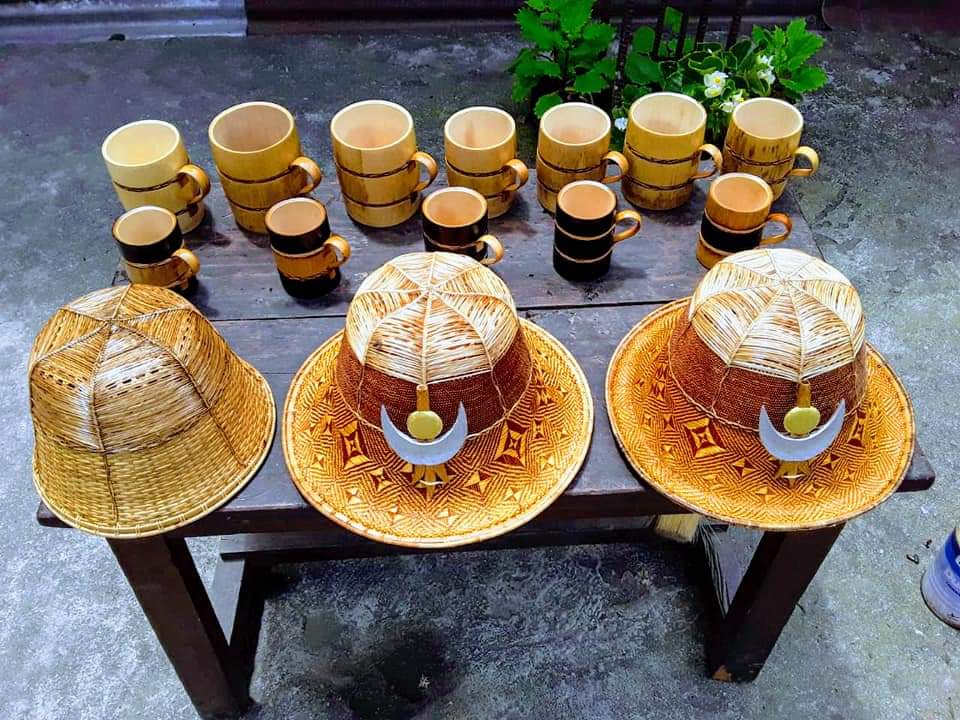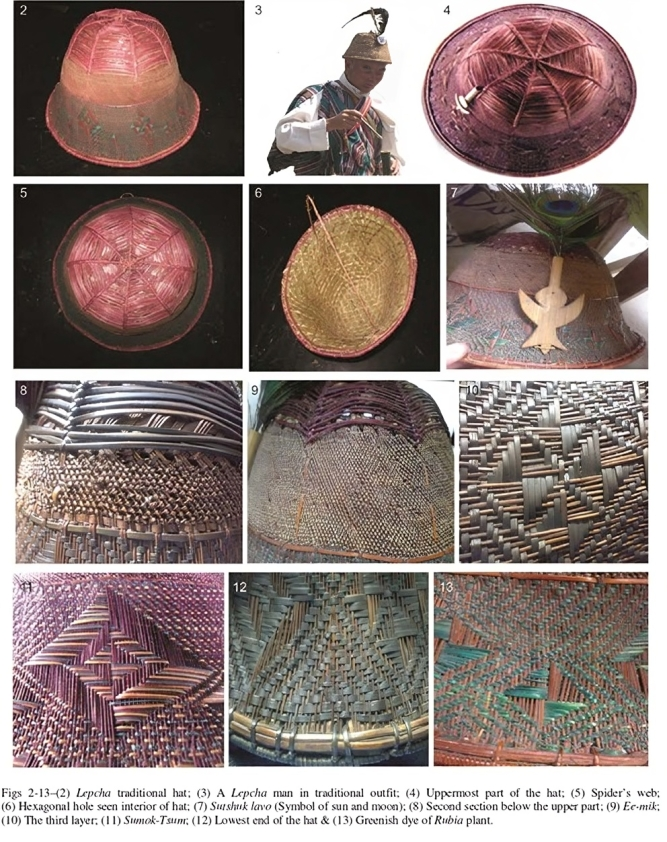A
Apoorva Devanshi
Guest
One of the people chosen for this year’s Padma Shri award was Jordan Lepcha. A Sikkim craftsman who creates bamboo hats embroidered with tales of historical events and family values. For the past 25 years, this 50-year-old craftsman from Mangan district’s Lower Lingdong has been preserving the Lepcha tribe’s cultural legacy.
Lepcha means “The Children of Snowy Peaks” or “The Children of God,” and people consider them as the aboriginal inhabitants of Sikkim. Mainly, they live in the foothills of southern and eastern Himalayas. With a population of around 50,000, they have largely remained closed off to the outside world for centuries. Keeping this in mind, the government of Sikkim, granted them the status of “Primitive Tribe” in 2005.
Nature is an intricate part of their lives as they have been nature worshipers. The practice of using cane or bamboo for household items has existed since centuries. They believe that keeping bamboo or cane wards off evil spirits.
The Sumok Thyaktuk, is Lepcha traditional hat which is exclusive to this tribe and is one of the oldest handmade craft. It is mainly made up of Ru (Cane) and Po-Young (Small bamboo). Lepcha people identify themselves with these hats and wear them on important festivals and occasions. They wear them on marriage ceremonies like Namsung or when offering prayer to Mt. Kanchenjunga etc.
It takes a skilled craftsman and approximately one month of time to make a single hat. Most of the time goes in preparation of fine thread like strings or Poli out of bamboo and cane to weave the hat. Then a natural dye is extracted from “Rubia Manjith,” plant and is used to dye the hat. The hat consists of four different layers and each layer signifies different traditional values.
Sungdyong, which translates to “spider web,” refers to the topmost layer. They weave this layer, which symbolises their savior “Mungkung-Mungla,” in a pattern that resembles a spider web. According to legend, this deity bestows good fortune and protects them from evil spirits.
“Ee-Mik,” or the local wasp’s eye, is the name of the second layer. This pattern features “Putka,” a local wasp. These mountain wasps provide honey of high medicinal value and thus hold significance in their lives. The weaving of this layer resembles thousand eyes of bees placed side by side to each other. It requires dexterity to weave such patterns using strings made of bamboo and cane. Then this section is dyed red or green is said to act as a pest repellant.
Sumok-Tsum is the third layer. It means the design of armour. The weavers interweave the bamboo and cane strips horizontally and vertically, creating triangular patterns. The tribe considers these patterns to be auspicious as they ward off negative thoughts.
Afyel forms lowest layer of the hat. It resembles an orchid, a plant native to the Himalayan region. They weave this section in a mountain shaped pattern. Then they weave the interior part of the hat in a hexagonal hole pattern. Finally, they carve the sun and moon on a small wooden or metallic piece. They carve it in such a manner that it can hold the feather of a holy bird. They then erect this piece on the top of the hat just above the forehead of the wearer. People believe that it symbolizes love and blessings and that it protects them from the ill effects of an eclipse.

Sumok Thyaktuk (Hat) made by Padma Shri Jordan Lepcha
Sumok Thyaktuk is indeed a unique and one of the oldest handicraft of Lepcha tribe. Its a highly Labour intensive process which requires skill, concentration and time. It takes a year to produce six-seven hats as there aren’t enough artisans left who know this art. In light of this, Mr. Jordan Lepcha plays a significant role as he’s been trying to preserve this dying craft. He has so far imparted his knowledge to over 150 youngsters from different parts of Sikkim. In my view, this craft is the identity of the their tribal community and must be preserved via a G.I tag. Honouring Mr. Jordan Lepcha with Padma Shri will help increase awareness. Yet combined efforts of government, NGO‘s and civil societies are required to preserve this dying craft.
The post Reviving Dying Art : Jordan Lepcha Receives Padma Shri appeared first on The Jaipur Dialogues.
Continue reading...
Who are Lepchas?
Lepcha means “The Children of Snowy Peaks” or “The Children of God,” and people consider them as the aboriginal inhabitants of Sikkim. Mainly, they live in the foothills of southern and eastern Himalayas. With a population of around 50,000, they have largely remained closed off to the outside world for centuries. Keeping this in mind, the government of Sikkim, granted them the status of “Primitive Tribe” in 2005.
Sumok Thyaktuk-
Nature is an intricate part of their lives as they have been nature worshipers. The practice of using cane or bamboo for household items has existed since centuries. They believe that keeping bamboo or cane wards off evil spirits.
The Sumok Thyaktuk, is Lepcha traditional hat which is exclusive to this tribe and is one of the oldest handmade craft. It is mainly made up of Ru (Cane) and Po-Young (Small bamboo). Lepcha people identify themselves with these hats and wear them on important festivals and occasions. They wear them on marriage ceremonies like Namsung or when offering prayer to Mt. Kanchenjunga etc.
Why Its Unique?
It takes a skilled craftsman and approximately one month of time to make a single hat. Most of the time goes in preparation of fine thread like strings or Poli out of bamboo and cane to weave the hat. Then a natural dye is extracted from “Rubia Manjith,” plant and is used to dye the hat. The hat consists of four different layers and each layer signifies different traditional values.
Sungdyong-
Sungdyong, which translates to “spider web,” refers to the topmost layer. They weave this layer, which symbolises their savior “Mungkung-Mungla,” in a pattern that resembles a spider web. According to legend, this deity bestows good fortune and protects them from evil spirits.
 Ee-Mik-
Ee-Mik-

“Ee-Mik,” or the local wasp’s eye, is the name of the second layer. This pattern features “Putka,” a local wasp. These mountain wasps provide honey of high medicinal value and thus hold significance in their lives. The weaving of this layer resembles thousand eyes of bees placed side by side to each other. It requires dexterity to weave such patterns using strings made of bamboo and cane. Then this section is dyed red or green is said to act as a pest repellant.
Sumok-Tsum-
Sumok-Tsum is the third layer. It means the design of armour. The weavers interweave the bamboo and cane strips horizontally and vertically, creating triangular patterns. The tribe considers these patterns to be auspicious as they ward off negative thoughts.
Afyel forms lowest layer of the hat. It resembles an orchid, a plant native to the Himalayan region. They weave this section in a mountain shaped pattern. Then they weave the interior part of the hat in a hexagonal hole pattern. Finally, they carve the sun and moon on a small wooden or metallic piece. They carve it in such a manner that it can hold the feather of a holy bird. They then erect this piece on the top of the hat just above the forehead of the wearer. People believe that it symbolizes love and blessings and that it protects them from the ill effects of an eclipse.

Sumok Thyaktuk (Hat) made by Padma Shri Jordan Lepcha
Preserving A Dying Art-
Sumok Thyaktuk is indeed a unique and one of the oldest handicraft of Lepcha tribe. Its a highly Labour intensive process which requires skill, concentration and time. It takes a year to produce six-seven hats as there aren’t enough artisans left who know this art. In light of this, Mr. Jordan Lepcha plays a significant role as he’s been trying to preserve this dying craft. He has so far imparted his knowledge to over 150 youngsters from different parts of Sikkim. In my view, this craft is the identity of the their tribal community and must be preserved via a G.I tag. Honouring Mr. Jordan Lepcha with Padma Shri will help increase awareness. Yet combined efforts of government, NGO‘s and civil societies are required to preserve this dying craft.
Last but not the least, If we are to Preserve Culture we must continue to create it.
The post Reviving Dying Art : Jordan Lepcha Receives Padma Shri appeared first on The Jaipur Dialogues.
Continue reading...
